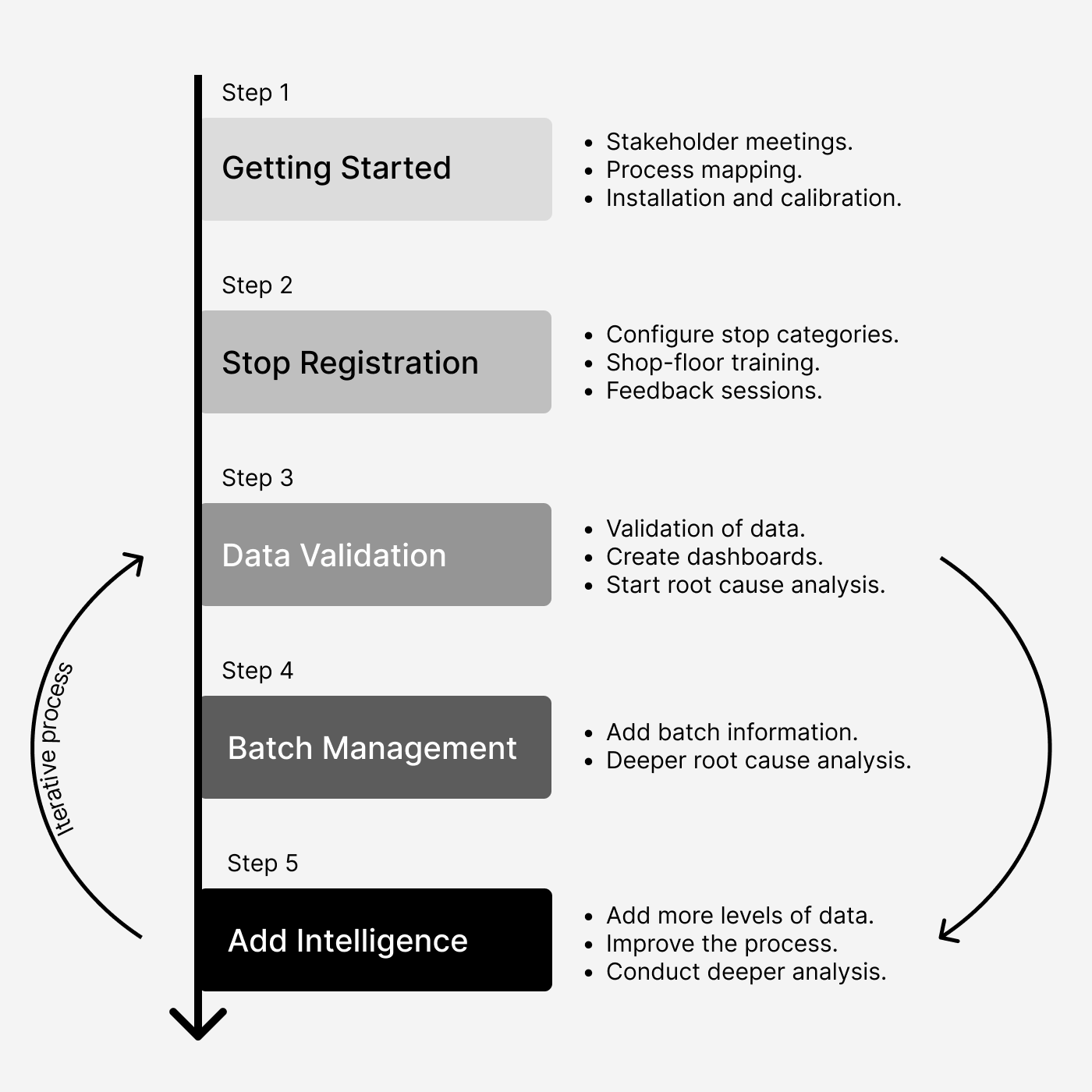The five-step Highway Solution for implementing new manufacturing systems
Manufacturing Matters Ep. 6
Mikkel Rauff Simonsen, Senior Manager of Plant Optimization, Danish Crown
Release Date: May 13, 2024

- Highway Solution Framework: A strategic approach for deploying the production monitoring systems across global manufacturing sites.
- Multi-Site Implementation Challenges: Tackles the complexities of integrating technology, standardizing processes, and cultural change across diverse locations.
- Keep It Simple: Get the fundamentals right and start with small-scale pilots.
- A Structured Approach: Scale up with step-by-step roll-out, training, and data validation to ensure effective adoption.
- Add Complexity: Update and enhance as new technologies and opportunities arise.
In the evolving landscape of global manufacturing, the need for structured approaches for integrating new technologies across complex global manufacturing setups is more critical than ever.To learn more about how to approach this challenge, I talked to Mikkel Rauff Simonsen, Senior Manager of Plant Optimization at Danish Crown, who has first-hand experience in rolling out Factbird across more than 40 sites.
We had a great conversation about the Highway Solution, a methodical approach that he has spearheaded that streamlines the deployment of production monitoring systems like Factbird. Below is a summary of what he had to say about the Highway Solution for rolling out new production monitoring solutions.
What is the Highway Solution?
The Highway Solution is a strategic framework that facilitates the streamlined implementation of manufacturing software across diverse production sites.In a nutshell, it is about:
- Creating consistency by establishing standardized procedures for deploying new production monitoring solutions.
- Creating tools and templates to support the implementation process, such as checklists, training materials, and documentation templates.
- Providing training to personnel to ensure they understand their roles and responsibilities.
- Conducting pilot tests to validate the effectiveness of the solution and make any necessary adjustments before scaling up deployment.
- Continuous improvement of how the new solutions are used through feedback, assessment, and taking advantage of new technologies or processes.
Why is the Highway Solution important?
The challenges that modern manufacturers face are accelerating change, particularly digitization, around the world. Accurate, real-time production data is being used to identify inefficiencies and spot opportunities, making it possible to get more out of existing equipment and keep production from being shut down and/or moving overseas to places where labor is cheaper.
Factbird is a popular tool for manufacturers who want accurate data, benchmarking based on facts, one common optimization language, and fact-based decision-making. But even with a user-friendly tool like Factbird, it’s not easy to introduce new procedures and tools to manufacturing sites, especially across multiple sites throughout different countries. Changing habits, shifting culture, getting buy-in on new processes, and getting consistency across large organizations with a large range of opinions is a formidable challenge.
Mikkel Rauff Simonsen and his team set up the Highway Solution to enable the smooth deployment of Factbird’s manufacturing intelligence solutions. By standardizing processes and tools, it reduces implementation time, minimizes disruptions to operations, ensures uniformity in data collection and analysis, and reduces risk.
Let’s dig into the five steps of the Highway Solution that Mikkel introduces in the podcast.

Step 1: Getting started
The initial phase involves setting the foundation for successful deployment. Here, you focus on the fundamentals, start seeing data, and start using the system. This includes configuring and calibrating sensors and establishing baseline data capture protocols on production lines.
Key activities involve:
- Hold meetings to help get stakeholder buy-in. This is not a one-off meeting; you need to be mindful of information overload and the value of recapping and giving space and time for questions.
- Detailed mapping of existing processes and identification of critical data points.
- Installation and calibration of plug-and-play Factbird IoT gateways and sensors to ensure accurate data collection.
- Alternatively, if possible, setup and test existing data sources like Kepware in the Factbird Cloud App.
- Ensure signals are being received in Factbird, set stop duration targets, shift schedules, etc.
Step 2: Stop registration
This very important step focuses on making sure you are getting the data. You want to have clear governance on how stops are labeled so that you can compare across sites, and if stop causes aren’t accurately registered, proper analysis and improvement in the future will not be possible.
Key processes include:
- Configure tablets and input devices with stop categories and causes.
- On-the-floor training and starting the registration of stops.
- Training and feedback sessions with operators to ensure accurate data entry.
- Training and feedback sessions with managers so that the data is utilized correctly.
- Continual follow-ups to deepen usage of the system.
Step 3: Data validation & visualization
At this stage, the integrity of the data collected is paramount. Activities focus on validating and making sense of the data through:
- Regular checks and validations to ensure data accuracy.
- Figure out what data managers and technicians need.
- Create dashboards that display relevant data that aids in decision-making and process adjustments.
- Start with simple visualizations and scale up along with the level of maturity.
Step 4: Batch management
Not every product is the same. Some are produced at 20 pieces per minute, and some at 40. Managing and analyzing production batches at the SKU or item number level allows for more detailed performance analysis.
This phase includes:
- Integration of Factbird with internal systems for seamless data flow and enhanced operational visibility.
- Detailed tracking of batch operations to analyze performance variations and identify optimization opportunities.
- Implementation of changes based on data-driven insights ensuring that each batch is managed more effectively than the last.
Step 5: Adding intelligence
The final step is a catch-all for further improvements to the process. In general, you should start simple and add complexity, and this is a space for adding that complexity after you have got the fundamentals right.
Adding intelligence could involve adding new solutions, like:
- Predictive maintenance to reduce equipment downtime.
- Using Factbird VIEW to find the root cause of equipment malfunctions quicker.
- Adding machine learning to the production analysis workflows.
So, in short, this final step is about continually refining and improving processes around the use of production monitoring solutions so that improvement doesn’t stand still.
A rocketship for success
And that’s it, the Highway Solution, a good example of how to tackle the deployment of new systems in large, complex operations. It emphasizes the importance of a structured, phased approach that not only addresses technological integration but also engages stakeholders in the use of the system.
You can watch or listen to the podcast to get a more detailed overview of the steps involved in the Highway Solution.
The benefits of rolling out solutions like Factbird across manufacturing sites are worth the investment. Reliable data, accurate comparisons across sites, improved visibility into production processes, and being able to track the results of changes are all very important for successfully and competitively making any kind of product.
For companies looking to navigate the complexities of deploying new manufacturing software, embracing such a comprehensive framework under the guidance of experts like Mikkel Rauff Simonsen is not just beneficial—it's essential.
Show Notes and Further Reading
- We’ll soon be releasing a video case study of how Danish Crown uses Factbird across its sites. Subscribe to our newsletter to get notified about this and other great content coming to help manufacturers.
- We covered more tips on deploying production monitoring solutions in an earlier episode of Manufacturing Matters when talking to Anders Homenlund about implementing manufacturing software across multiple sites.
- You can see Factbird’s Cloud App in action for free here: Factbird video demo.
Remember to subscribe to Manufacturing Matters to get notified when the next episode is available on Spotify, Apple Podcasts, YouTube, Amazon Music, and other popular podcast directories.


.svg.png)


